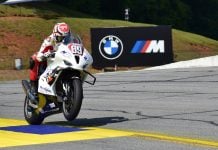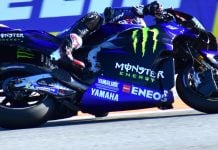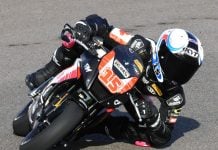Although it appears to be largely unchanged, Yamaha has essentially redesigned the YZF-R1 for 2007 to give it more and cleaner horsepower and improve its handling all while keeping its “iconic” styling similar. The biggest change to the new YZF-R1 is in the engine department. Going against a Yamaha sportbike tradition, the Genesis five-valve cylinder head layout has been abandoned in favor of a more conventional four-valve cylinder head. “It used to be, ‘How can we add more power?'” said Yamaha Motor Corp., U.S.A. Product Planning Manager Derek Brooks. “Now it’s, ‘How can you meet the new exhaust emissions and not lose horsepower?’ “By using the five-valve design you are a little bit constricted in how much you can shape the combustion chamber. By switching to a four-valve design [with titanium, instead of steel, intake valves; exhaust valves remain steel] it gave the engineers a little more freedom. They’ve reshaped the combustion chamber area, raising compression slightly [12.4:1 to 12.7:1]. So it helps meet emissions but at the same time not lose horsepower.” Yamaha claims peak horsepower for the ’07 R1 is up to 178 at 12,500 RPM (at the crankshaft), a five horsepower increase. Yamaha also claims that horsepower output is up throughout the 13,750 RPM rev range of the new bike thanks to new high-tech intake and fuel-injection systems. Like its YZF-R6 little brother, the new YZF-R1 gets the Yamaha Chip Controlled-Throttle (YCC-T) system, in which the computer controls the butterfly valves in the throttle bodies via an electric motor as much as the rider controls the butterfly valves with the throttle grip. The YCC-T system is claimed to monitor several different parameters every 0.001 second to provide precise throttle and engine management. The YCC-T on the new R1 also works in conjunction with a new system, the Yamaha Chip Controlled-Intake (YCC-I), variable intake system. With the YCC-I, velocity stacks above the throttle bodies are fitted to an actuator that can move them between two positions (and only two positions), varying the intake tract length from 65 to 140mm, to maximize power output based on the engine’s needs at the time. According to Brooks, there is no magic RPM number where the velocity stacks change position. Connecting rods have been strengthened by adding material, but bore x stroke remains at 77 x 53.6mm. The crankshaft and engine cases of the engine are unchanged, but the six-speed transmission gets the slipper-style clutch from the 2006 YZF-R1 LE, which will not return in 2007. The engine is held in a completely new frame that has had the rigidity near the steering head area optimized to improve turn-in and front end feel. Working in conjunction with the new frame are a new set of 43mm inverted forks, which come with thinner slider tube walls, larger-diameter pistons, new aluminum rods and increased axle bracket rigidity. Rake of the forks is set at 24°. Trail was not available at post time. The 3.5 x 17.0- and 6.0 x 17.0-inch wheels, front and rear, are two of the only things that carry over from the 2006 model YZF-R1, but the front brake system is different. The front calipers have gone from four-piston units to a six-piston/four-pad version. This set-up puts the pads farther away from the axle, effectively increasing the brake rotor diameter and allowing the actual brake rotor diameter to be decreased from 320 to 310mm for a reduction in the inertial moment at the axle and lighter handling, according to Yamaha. The front of the new R1 is also graced with a curved radiator to maximize radiator surface area while minimizing frontal area and drag. The rear suspension of the bike has also been reworked. The shock retains the same shock body, but the internals have been changed to increase the progressive rate of damping from 8 to 14% (to improve off-corner traction) and to allow high- and low-speed compression damping adjustability. Where the shock and up pipe of the exhaust system passed through the same hole in the swingarm last year (leading to some heat issues affecting the performance of the shock), the up pipe of the exhaust now passes on the ride side of the redesigned, asymmetrical swingarm. The new swingarm has 30% more torsional rigidity, slightly less lateral rigidity, more room for larger racing tires and a 3mm higher pivot position in the frame. The exhaust is now made largely of titanium in an attempt to offset the weight of a second catalytic converter put inline with the original. Dual under-seat mufflers are still used. The new R1 comes standard with Pirelli Diablo Corse tires, like the 2006 LE model. Wheelbase is 1415mm (55.7 inches). Neither dry weight nor price were available at post time, but both were expected to go up slightly. Bikes are expected to start arriving in dealerships as early as late-November. The available colors are Yamaha Blue, Charcoal Silver/Matte Black and Candy Red/Matte Black. Yamaha is planning to unveil the new 2007 YZF-R1 to the public at four special events: October 14, 9:00 a.m. to 12:00 p.m., at Old Bridge Township, Raceway Park, Englishtown, New Jersey; October 14, 9:00 a.m. to 12:00 p.m., at Alice’s Restaurant, Woodside, California; October 20, 6:00 p.m. to 9:00 p.m., at Daytona International Speedway, Daytona Beach, Florida; and November 2-5 at the Lone Star Rally, Harborside Lots, Galveston, Texas. Jason DiSalvo is scheduled to appear at the New Jersey event, while Wayne Rainey, Eddie Lawson and Eric Bostrom are slated to appear at Alice’s restaurant. Yamaha Motor Corp. U.S.A. is expected to announce its 2007 AMA road racing plans at the October 14 events. The YZF-R6 is largely unchanged for 2007. It comes in new colors, the same three options as the new R1, and the only different part of the bike is the tachometer. In place of the 2006 tachometer, which included an optimistic 17,500 RPM redline, is a tachometer with more realistic 16,500 RPM redline for 2007. The FJR 1300 model only gets new colors for 2007. The AE push-button shift model comes in Cerulean Silver, while the standard-shift A model comes in Black Cherry. Likewise, the FZ1 gets two new colors: Raven Black and Cobalt Blue. The FZ6, however, gets a host of refinement changes for 2007. The front fairing and headlight shape has a more aggressive style, while the bodywork pieces are now painted (either Candy Red or Cobalt Blue) instead of injection molded in a color. New forks provide improved damping and smoother action. The new FZ6 comes with four-piston monoblock Sumitomo front brake calipers, which have been standard on Yamaha’s YZF sportbikes for the past few years. The box steel swingarm on last year’s FZ6 has been replaced with an extruded aluminum unit. The new FZ6 also gets an instrument package similar to the FZ1, including a multi-function display that has dual tripometers, a low-fuel tripometer, etc.
Yamaha Announces New YZF-R1 With Four-valve Head And Variable Intake System
Yamaha Announces New YZF-R1 With Four-valve Head And Variable Intake System
© 2006, Roadracing World Publishing, Inc.






